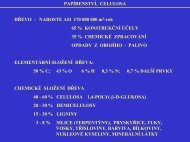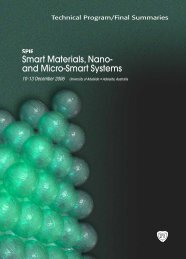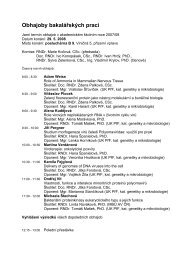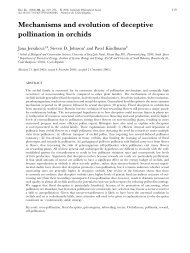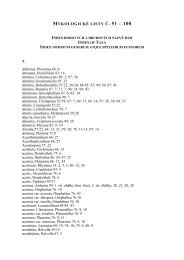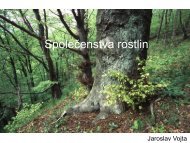Spatial distribution of phytoplankton in the eastern part of the North ...
Spatial distribution of phytoplankton in the eastern part of the North ...
Spatial distribution of phytoplankton in the eastern part of the North ...
- No tags were found...
Create successful ePaper yourself
Turn your PDF publications into a flip-book with our unique Google optimized e-Paper software.
4. DiscussionAlong <strong>the</strong> transect, vertical and horizontal gradients <strong>of</strong> algal concentration and species numberwere found. Three groups <strong>of</strong> stations were found based on different <strong>phytoplankton</strong> composition:Most <strong>of</strong> <strong>the</strong> species were most abundant ei<strong>the</strong>r at <strong>the</strong> coastal or at <strong>the</strong> oceanic end <strong>of</strong> <strong>the</strong> transect,while some species occurred ma<strong>in</strong>ly at stations located <strong>in</strong> <strong>the</strong> deeper area <strong>in</strong> <strong>the</strong> middle <strong>of</strong> <strong>the</strong>transect. High concentrations <strong>of</strong> diatom cells per ml were noted at both ends <strong>of</strong> <strong>the</strong> transect.However, <strong>the</strong> algal composition <strong>of</strong> stations situated at <strong>the</strong> <strong>eastern</strong> and <strong>the</strong> western end <strong>of</strong> <strong>the</strong>transect, respectively, were different. Generally, <strong>the</strong> highest species diversity <strong>of</strong> all algae groupswas found at station with <strong>the</strong> lowest number <strong>of</strong> algae per ml. This phenomenon is known not onlyfrom mar<strong>in</strong>e environment but also from all types <strong>of</strong> natural conditions, as has been published e. g.by LEVIN et al. (2001). A vertical gradient <strong>in</strong> species number <strong>of</strong> diatoms and d<strong>in</strong><strong>of</strong>lagellates wasfound <strong>in</strong> <strong>the</strong> middle <strong>part</strong> <strong>of</strong> <strong>the</strong> transect. The gradient was probably caused by slight stratification,appeared as small vertical gradients <strong>of</strong> temperature and sal<strong>in</strong>ity at station 151 (Figs 2., 3.).The level <strong>of</strong> temperature and sal<strong>in</strong>ity was more or less constant along <strong>the</strong> whole transect, a<strong>part</strong>from two stations at <strong>the</strong> west coast <strong>of</strong> Denmark. There <strong>the</strong> water was colder and less sal<strong>in</strong>e probablydue to <strong>the</strong> <strong>in</strong>fluence <strong>of</strong> fresh water from estuaries along <strong>the</strong> coast <strong>of</strong> Denmark. A very differentpattern was found <strong>in</strong> <strong>the</strong> spatial <strong>distribution</strong> <strong>of</strong> fluorescence values. Two dist<strong>in</strong>ct peaks <strong>of</strong>fluorescence occurred at stations 157 and 147, located at <strong>the</strong> opposite ends <strong>of</strong> <strong>the</strong> transect. In <strong>the</strong>middle <strong>part</strong> <strong>of</strong> <strong>the</strong> transect, very low chlorophyll concentrations were found. This <strong>distribution</strong> <strong>of</strong>chlorophyll was obviously associated with <strong>the</strong> water depth. High values <strong>of</strong> chlorophyll weremeasured <strong>in</strong> <strong>the</strong> shallow <strong>part</strong>s <strong>of</strong> <strong>the</strong> transect, while <strong>in</strong> <strong>the</strong> deepest <strong>part</strong> (station 151) <strong>the</strong> lowestconcentration was found. While <strong>the</strong> <strong>eastern</strong> end <strong>of</strong> <strong>the</strong> transect was <strong>in</strong>fluenced by coastal proximity,<strong>the</strong> small depth at <strong>the</strong> western end <strong>of</strong> <strong>the</strong> transect was caused by <strong>the</strong> vic<strong>in</strong>ity <strong>of</strong> <strong>the</strong> shallow areaDogger Bank (JOHNS & REID 2001). These two zones were separated by an area with depths <strong>of</strong> 35 –40 meters. The high algal abundance at both ends <strong>of</strong> <strong>the</strong> transect was probably caused by <strong>the</strong>nutrients richness <strong>in</strong> shallow, mixed <strong>part</strong>s <strong>of</strong> <strong>the</strong> sea, that evoked <strong>the</strong> <strong>phytoplankton</strong> bloom.However, we did not measure any nutrients concentrations to support this hypo<strong>the</strong>sis.At both ends <strong>of</strong> <strong>the</strong> transect, <strong>the</strong> high values <strong>of</strong> fluorescence were probably caused by <strong>the</strong> largenumber <strong>of</strong> diatoms, which are typical organisms <strong>of</strong> spr<strong>in</strong>g blooms <strong>in</strong> mar<strong>in</strong>e environments (JOHNS& REID 2001). However, we could not absolutely rule out that <strong>the</strong>se values were caused by o<strong>the</strong>rorganisms, for example by those, which are nanoplanktonic. They could contribute to <strong>the</strong> measured21




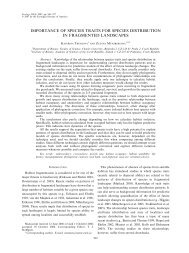
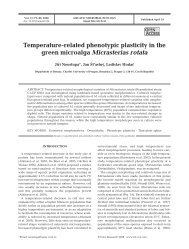
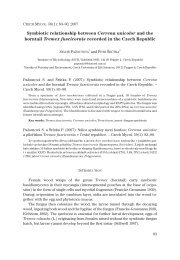
![[Cr(urea)6]Cl3](https://img.yumpu.com/47220263/1/184x260/crurea6cl3.jpg?quality=85)
